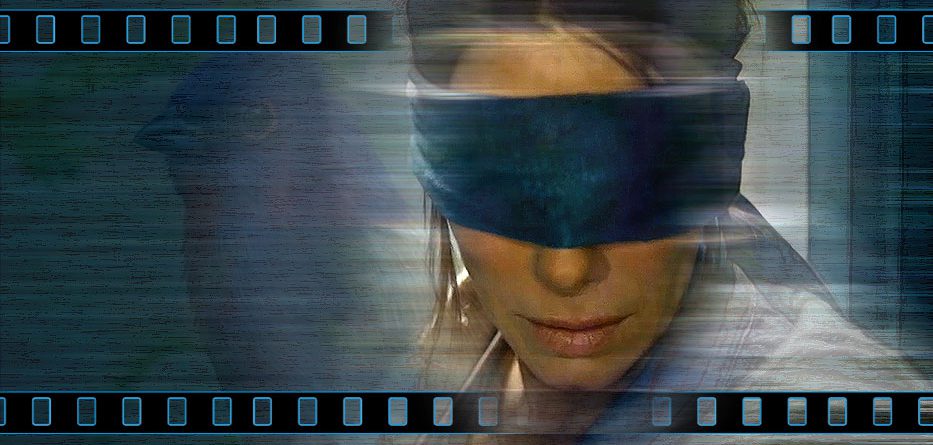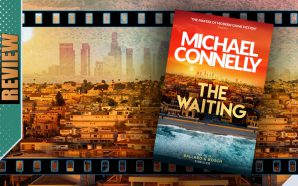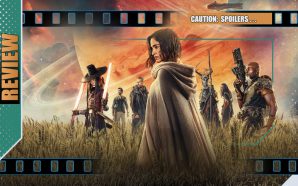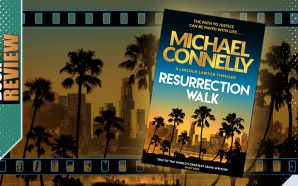A young woman named Malorie (Sandra Bullock) instructs two young children on the importance of following her rules to the letter. They can’t question her decisions. They can’t remove their blindfolds. If they do, they will die. The journey ahead will be difficult and they must literally hang on for dear life as the three of them set off on a fateful trip down a nearby river…
Five years ago: Malorie is an outlier artist struggling to both make a successful income and deal with an unplanned pregnancy. However her world is turned upside down in an instant when a strange global phenomenon reaches the American mainland and creates chaos. People who catch sight of something immediately turn suicidal and in a matter of hours, the streets are strewn with dead bodies and smouldering wrecks. Purely by chance, Malorie is one of a handful of immediate survivors who manages to make it to the safety of a nearby house where neighbour Douglas (John Malkovich) is less than happy to suddenly have a group of ‘refugees’ in the living room – and it’s not even his house. But as it becomes clear the scale of the disaster and the degree to which the unseen threat continues outside the home’s doors, everyone begins to realise that their normal way of life has ended and that the future must be survived – sight-unseen…
The secret of A Quiet Place‘s threat was one of chilling single-sentence simplicity: an enemy that tracked you through sound and the subsequent way that humanity had to change its everyday existence to survive. That film’s box-office success was a reflection of the effective execution and sheer momentum of that streamlined, clinical idea and the subsequent delivery of it by its actors. While Bird Box certainly has a similar sensory-shredding apocalyptic core and equal, even increased requisite star power (Sandra Bullock, John Malkovich, Sarah Paulson, Tom Hollander all giving it their all), it proves to be less satisfying.
After the initial chaotic outbreak and the understandable tsunami of despair and confusion felt by the small group of survivors, the story sets out its stall and asks some of the right, interesting questions. Early developments – such as exploring whether ‘viewing’ the threat via electronic images is as dangerous as seeing it with the naked eye – seem like smart moves, establishing the framework of the main characters feeling out the boundaries of their new and more limited world. Alliances, fragile and fractured though they are, start to form as disparate people find some common ground, ways to adapt and even some gallows humour in their predicament. So far, so good. But once the Bird Box set-up is there, the imperatives – so absolute and absolutely, consistently important in A Quiet Place – quickly start to get diluted. The single sentence pitch (now an enemy that makes you kill yourself when you see it) suddenly gets annotated and footnoted as convenient caveats and exceptions are introduced merely to keep that innate tension going. A seemingly unstoppable and world-killing threat that can be seen from, but can’t pass through, a doorway? Invisible forces able to move objects but not attack humans directly? Exposure to being ‘seen’ making some people kill themselves but which makes the mentally-impaired and deranged conveniently act like duplicitous Lifetime Channel bad guys or NatGeo survivalists? Add to these inconsistencies the fact that the threat’s only direct screen presence is either shadows under a door, a swirling stack of leaves or something indistinct glimpsed through a hessian-bag blindfold and there’s not enough ‘there’ there to truly chill.
Equally, the story flips backwards and forwards between the initial outbreak of five years previously(and the immediate weeks afterwards) and Bullock’s ‘present-day’ dangerous journey down a river to what may or may not be some sort of salvation for her and two children she has with her. While that offers two differently claustrophobic strands of tension and narratives that ultimately need connecting, it also adds to the obvious conclusion that a majority of the supporting cast we see in the earlier time-frame are mostly collateral damage and so it becomes the formulaic pattern of ‘what will happen to them and when?’.
Visually, director Susanne Bier (The Night Manager) does well enough with the material (as do Trent Reznor and Atticus Ross with the score) and there are key moments when the cinematography is effective in its choices, but the cast of characters assembled don’t push any boundaries and In most cases it’s easy to see the wisdom of the casting process. Malorie is supposed to be likeably unlikeable, a bristly loner handling a pregnancy she never wanted and tolerating the world with a weary smile. Bullock is fine in the role, but – ironically – she could handle such ‘determined’ material with her eyes closed. Paulson is the supportive, sensible sister and Malkovich is the pragmatic grouch who is happy to throw acerbic insults at the world. The likes of slightly less household names Dumplin and Patticake$‘ Danielle Macdonald and The Predator‘s Trevante Rhodes probably do better work with the roles they have.
Netflix‘s big-budget original films have embraced a wide breadth of quality and result and, creatively, Bird Box falls somewhere just above the middle – interesting but flawed. Had A Quiet Place not been so good, then Bird Box might have seemed edgier than it now appears, but even attempting to judge it on its own merits one cannot ignore the extent it also draws from M. Night Shyamalan’s sleepy The Happening and Yolanda Ramke’s under-rated 2017 sleeper Cargo. It’s an improvement on Shyamalan’s esoteric,ecological effort (but that’s hardly a glowing recommendation) but lacks the heart of Ramke’s earnest outback quest. To be fair, the source material, Josh Malerman’s 2014 debut novel of the same name, is probably proof-positive that a book in which the reader must conjure up their visions of a threat the story’s protagonist literally dare not see, is always going to be superior to a more visual adaptation forced to give it a firmer form.
Bird Box is available on Netflix now…
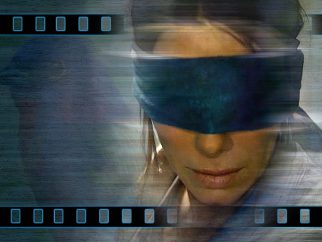
- Story8
- Screenplay7
- Acting8
- Directing8

